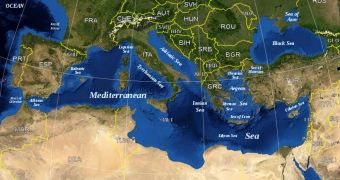Geologists studying how the Mediterranean Sea formed now propose that the large body of water that separates Europe from Africa must have been created when waters from the Atlantic Ocean breached the strait of Gibraltar. They hypothesize that a large basin lay just below the strait's barrier, and that it was well below the sea level. This allowed incoming water to take up “residence” in the area, some 5.6 million years ago, LiveScience reports.
At first, the sea was formed around 5.6 million years ago, due to a large-scale flood, but the waters were separated from the Atlantic Ocean by the Strait of Gibraltar, so, in the hundreds of thousands of years that followed, the water spreads dried out almost completely. But the sea was saved due to tectonic activity. The plate on which the Gibraltar Strait lay started subsiding, allowing the waters of the Atlantic to again breach the barrier and fill the basin back up again. This happened some 5.3 million years ago, the generally agreed-upon age of the modern Mediterranean Sea.
But experts have been having a difficult time assessing exactly how the waters were able to cut their way through the complex geological makeup of the Gibraltar Strait. They were also curious about precisely how much time it took for them to do so. A new set of scientific studies now demonstrates that the entire process took a few thousand years. During these times, the Atlantic water drilled more than 124 miles (200 kilometers) into the strait, creating a navigable channel of roughly the same shape and size as the one we see today.
The new conclusions were based on scientific data collected by geologists at drill sites in Gibraltar, as well as from seismic records of tremors and tectonic activities that churned the area in the past. The team behind the new work estimates that, at first, it took several thousand years for the water to start filling the basin, setting the scene for the gargantuan flood to come. It is estimated that about 90 percent of the water in the Mediterranean Sea settled in in a time frame of a few months to two years. Scientists say that peak sea-level rises within the basin could reach up to 33 feet, or ten meters, each day.
The work was conducted by scientists at the Barcelona, Spain-based Institut de Ciencies de la Terra Jaume Almera, CSIC, and was led by expert Daniel Garcia-Castellanos. In a scientific paper published in the December 9 issue of the respected scientific journal Nature, the team says that the flood did not resemble a giant Niagara Falls. They argue that the Atlantic waters came in the form of a huge water ramp, several miles wide, descending from the ocean into the basin below.

 14 DAY TRIAL //
14 DAY TRIAL //